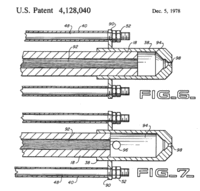- Muzzle booster
-
A muzzle booster or recoil booster is a device affixed to the muzzle of a firearm, intended to harness the energy of the escaping propellant to augment the force of recoil on portions of the firearm. Muzzle boosters are usually used to improve the reliability of a recoil operated firearm. The muzzle booster is the antithesis of the muzzle brake, which is designed to use the propellant gases to reduce the recoil of the firearm.
Contents
History
The recoil booster was first introduced in the Vickers machine gun of 1912. The Vickers, like the Maxim gun from which it was developed, uses a short recoil action. At firing the recoil from the cartridge pushes the barrel backwards within the gun. This movement provides the energy required to extract and eject the spent cartridge, and compresses the recoil spring to complete the cycle. The muzzle booster increased the recoil transmitted to the barrel by directing some of the escaping gas into pushing the barrel back rather than letting it all expand outwards at the muzzle. This increased the initial velocity of the barrel and lock, providing more energy for the operation of the mechanism.
Construction
The booster on the Vickers consists of two parts; the first is a flared "cup" on the muzzle of the barrel and the second is a perforated tube around the end of the muzzle. As the bullet exits the barrel, it passes through the close tolerance hole in the end of the perforated tube. As it does so it temporarily forms a blockage to further forward movement of the expanding gas from the barrel. The pressure inside the booster rises, as the gases are forced to reverse direction to escape the booster. The cup on the muzzle of the barrel provides a large surface for the gas to push against, and the increased pressure accelerates the barrel to the rear. The resulting action can be seen as a composite of the recoil action and a gas action — the barrel being acted upon as if it were the piston.
Historical applications
The original use of the recoil booster was to provide additional energy to move the large barrel mass on recoil operated machine guns. The much later German MG42 was another such machine gun which also made use of a muzzle booster. This application has largely fallen out of use as modern machine gun design switched to delayed blowback and gas operation in many cases. The Rheinmetall MG3, essentially an MG42 modified to use the standard 7.62×51mm NATO round, and currently used by the German military, still uses a boosted short recoil design.
 Drawings from US patent 4,128,040, for a blank firing adapter for the short recoil operated M2 Browning machine gun
Drawings from US patent 4,128,040, for a blank firing adapter for the short recoil operated M2 Browning machine gun
Modern applications
Recoil boosters have found a new use in suppressors on Browning-pattern recoil operated pistols (i.e., most modern centerfire pistols). Such pistols have a barrel which recoils a short distance upon firing before unlocking from the slide. Adding the mass of a suppressor to a recoil operated pistol significantly adds to the recoiling mass, and the extra inertia of the suppressor can slow or even stop the recoil action of the barrel. By incorporating a recoil booster, often called a Nielsen device, the weight of the suppressor can be uncoupled from the barrel, allowing the pistol to function properly by boosting the recoil energy of the barrel and slide. Many suppressor boosters incorporate an indexing system which allows the suppressor to be re-oriented in a number of different rotational positions, allowing the end user to fine-tune the weapon's point of aim.
Some blank firing adapters (BFAs) act as recoil boosters, harnessing the gases produced by the blank cartridge to compensate for the lack of recoil from the bullet.
Categories:- Firearm components
Wikimedia Foundation. 2010.





